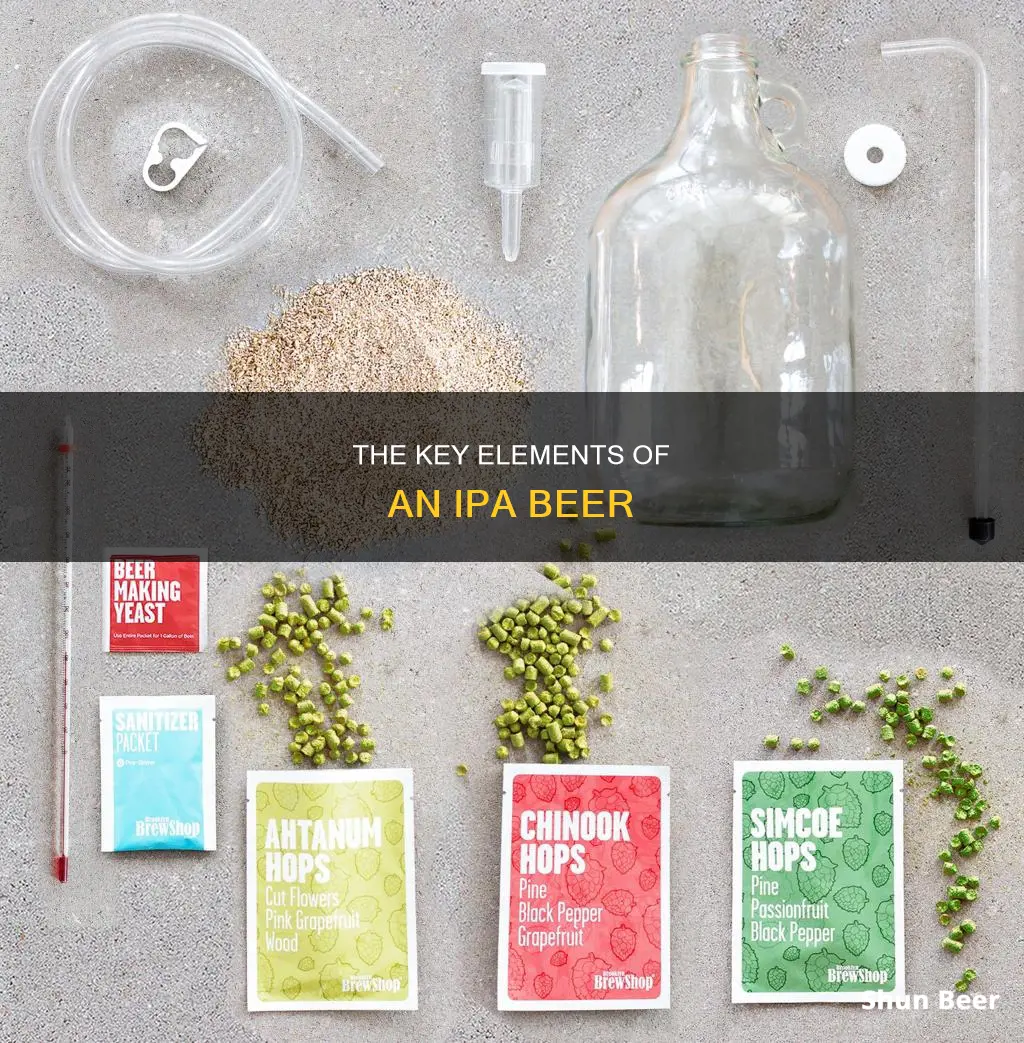
India Pale Ale, or IPA, is a hoppy beer style within the broader category of pale ale. It was originally an export beer shipped to India under the control of the British East India Company until 1858. The IPA was invented in Britain, where sailors were looking for a beer recipe that would be easy to preserve on long trips from Britain to India. The IPA has since evolved into its own unique style, with modern American IPAs tending to be around 6-7% ABV. However, IPAs can be bitter and contain high alcohol levels, depending on the variety of hops used. Some popular IPA styles include West Coast IPA, British IPA, and New England Style IPA.
What You'll Learn

Alcohol Content
The alcohol content of an IPA, or India Pale Ale, varies depending on the style and type. Generally, modern American IPAs tend to have an ABV of around 6-7%. However, there are several variations of IPAs with different alcohol contents.
Session IPAs, for example, are designed to be consumed in larger quantities during a drinking session with friends. These IPAs typically have a lower ABV of around 4-5%. On the other hand, Double or Imperial IPAs are stronger and have a higher alcohol content, usually exceeding 7%. The term "double" refers to the increased amount of ingredients used, particularly hops, resulting in a beer that is richer in hop character and higher in alcohol content.
Triple IPAs take this a step further, with alcohol content typically surpassing 10% ABV. These beers are characterised by even higher hop flavours and a more intense drinking experience.
The original IPAs, dating back to the British Empire and their colonies, were brewed with a higher ABV to withstand long journeys and long-term storage. However, today's IPAs are best enjoyed fresh and cold, and the alcohol content is just one of many factors that contribute to the unique characteristics of this popular beer style.
Abita Beer's Exploration of IPAs: A Comprehensive Guide
You may want to see also

Hoppiness
The hoppiness of an IPA, or India Pale Ale, is largely what defines it. IPAs are a style of pale ale that emphasises hop flavours and aromas. They are brewed to be hop-forward, meaning the bitter, fruity, and floral qualities of hops are accentuated over other elements of the flavour profile.
The hoppiness of an IPA is determined by the types of hops used, and there are dozens of distinct hop varieties to choose from. Each variety has its own unique smell and taste, and new varieties are developed every year. Hops grown in the Pacific Northwest of the US are the most popular, but hops are sourced from all over the world, including Australia, New Zealand, England, and Germany.
The level of hoppiness in an IPA can be influenced by the amount of hops used, with double or imperial IPAs using a higher concentration of hops, resulting in a beer that is both higher in alcohol content and richer in hop character.
The dryness of an IPA can also affect its hoppiness. Dry-hopping is the process of steeping hops in fermenting beer instead of adding them while the liquid is boiling. This creates an extremely strong aroma, amplifying the fruity, piney, and candy-sweet notes of the hops, without adding any bitterness.
The style of IPA will also determine its hoppiness. A traditional West Coast IPA is hoppy, fruity, and crisp, while a British IPA tends to be very hoppy and one-note, with less complex flavours. A New England-style IPA is unfiltered, extremely low in bitterness, and hazy in appearance, with an emphasis on hop aroma.
The Slow Decline of IPAs: What's Next for Beer?
You may want to see also

Fruitiness
The fruitiness of IPAs can be enhanced through techniques such as dry-hopping, where hops are steeped in the fermenting beer instead of being added during boiling. This amplifies the fruity notes of the hops without adding bitterness. Additionally, brewers may add pureed fruit or fruit juice during the brewing process to further intensify the fruitiness of the beer.
The type of hops used and the brewing techniques employed can vary depending on the style of IPA. For example, West Coast IPAs are known for their prominent fruit notes, while British IPAs tend to be maltier and less fruity. New England IPAs, on the other hand, are known for their hazy appearance and low bitterness, with a focus on intense fruity flavors.
The fruitiness of IPAs is a key factor in their popularity, offering a range of flavors that appeal to a wide range of drinkers. Brewers continue to experiment with different hop varieties and brewing methods to create new and interesting fruit-forward IPAs.
Stouts Similar to Guinness: Exploring Dark Beer Alternatives
You may want to see also

Bitterness
The bitterness of an IPA is influenced by several factors, including the type of hops used, the amount of hops added, and the brewing process.
Hops are the key ingredient that contributes to the bitterness of an IPA. Hops are the green, cone-like flowers of the humulus lupulus plant and contain compounds that impart a bitter flavour and aroma to the beer. Different varieties of hops can provide unique bitter characteristics, and brewers can select specific hops to achieve the desired level of bitterness in their IPAs.
The amount of hops added during the brewing process will also affect the bitterness of the IPA. A higher concentration of hops will generally result in a more bitter beer. This is particularly true for double or imperial IPAs, which use a larger amount of hops, resulting in a stronger and more bitter flavour profile.
Additionally, the brewing process can impact the bitterness of an IPA. For example, dry-hopping is a technique where hops are steeped in the fermenting beer instead of being added during the boiling process. This enhances the aroma of the beer without adding significant bitterness.
The bitterness of an IPA can also be influenced by the style and origin of the beer. Traditional British IPAs tend to be very hoppy and bitter, with a malty flavour. On the other hand, New England-style IPAs are known for their low bitterness and emphasis on fruity flavours. West Coast IPAs strike a balance between fruitiness and bitterness, offering a crisp and hoppy taste.
Furthermore, the International Bittering Units (IBU) scale is used to measure the bitterness of a beer, with higher IBU ratings indicating a more bitter IPA. Most IPA beers fall within the range of 40 to 70 IBUs, but this can vary depending on the specific recipe and brewing techniques employed.
What Defines an IPA Beer?
You may want to see also

Origins
The origins of India Pale Ale (IPA) date back to the British Empire and its colonies. During the 18th century, British sailors sought a beer recipe that would be easy to preserve on long trips from Britain to India. The hot and wet weather in India was not conducive to brewing good beer, so sailors needed a beer that could survive the journey.
George Hodgson of Bow Brewery is credited with first exporting porters and pale ales to India in 1793. However, it wasn't until forty years later that the name "East India Pale Ale" was first used. Brewers were advised that it was "absolutely necessary" to add hops to beer being sent to tropical climates, as hops acted as a preservative.
Early IPAs were only slightly higher in alcohol content than other beers of the time, but they were heavily hopped and formulated to survive long voyages by sea. By the 1860s, IPAs were widely brewed in England and had become a popular product.
In the 20th century, the IPA style experienced a revival, with a seminar on Burton pale ales organised by publican Mark Dorber in 1990 leading to a series of festivals and conferences dedicated to the style.
In the late 20th century, craft beer revolution in the United States, brewers began experimenting with old beer styles that had fallen out of fashion. The traditional IPA style proved to be a perfect fit for the intense flavour and aroma of American hops. The popularity of IPAs spread across the United States and eventually the world, with over 40% of craft beer brewed in the US now classified as an IPA.
Today, IPAs come in a range of styles, including West Coast, New England, British, Double/Imperial, Session, and more. While the style has evolved, the hoppy quality that originated from its preservation purpose has largely remained.
Guinness Beer: Available in India?
You may want to see also
Frequently asked questions
IPA stands for Indian Pale Ale or India Pale Ale.
IPAs are hoppy beers with a bold, bitter, fruity, or floral flavour. They can be light and crisp, or heavy and intense.
There are several types of IPA, including West Coast IPA, British IPA, New England IPA, Session IPA, Double or Imperial IPA, and Triple IPA.







